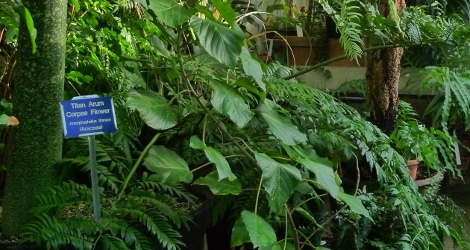Accession Data:
Triphasia trifolia (Burm.f.)P.Wilson.
- Common Name: Limeberry
- Family: Rutaceae Juss.
- Country of Origin: Southeastern Asia, East Indian Archipelago
- Description: A glabrous shrub or small tree with terete twigs bearing paired spines in the axils of the leaves; leaves 3-foliolate, the terminal leaflet ovate with a cuneate base and a rounded emarginate tip, 2-4 X 1.5-2 cm; lateral leaflets much smaller than the terminal one (1-2-2 X 0.8-1.2 cm), broadly rounded at the tip, cuneate at the base; petiolules very short (1.5-2 cm); petioles short (3-5 mm), wingless; flowers appearing singly or 2 or 3 in the axils of the leaves; peduncles short (3-4 X 1 mm); flower buds cylindrical, 10-12 X 3-4 mm; flowers 3-merous (but with 6 stamens); sepals small (1.5-2 mm long), 3-lobed, green, persistent; petals white, 10-13 X 3.6-4.5 mm; staminal filaments slender, glabrous, 9-11 mm long, anthers oblong, 2 X 1 mm; disk annular or short-cylindric; ovary ovoid or fusiform with 3 locules, each with 1 ovule, narrowed into a slender, deciduous style with a capitate, 3-lobed stigma; fruit ovoid or subglobose, sometimes apiculate, 1.2-1.5 cm long, dull reddish-orange or crimson when fleshy ripe; peel with many small oil glands; seeds 1-3, immersed in mucilaginous pulpy flesh.1
- Uses: Plant produces a small 10-15mm berry like hesperidium that has an acidic, lime-flavored taste. Fruits are eaten directly, cooked to make a preserve or used in a beverage.
- IMPORTANT NOTE: Plant Uses are for informational purposes only. EEB Greenhouses assume no responsibility for adverse effects from the use of any plants referred to on this site. Always seek advice from a professional before using any plant medicinally.
- USDA Zone: 9b-11
Accession Data:
- Accession # 200700167
- Source: Chad Husby FIU
- Accession Date: 09-18-2007
- Bench: 1214 - AUS:West Bench SC
- Currently: active - healthy
- Qty: 2 confirmed on 03-24-2025
Classification:
- Division: Magnoliophyta
- Class: Magnoliopsida
- SubClass: eurosid II
- Order: Sapindales
- SubOrder:
- Family: Rutaceae
- SubFamily: Aurantioideae
- Tribe: Citreae
- SubTribe: Triphasiinae
Flowering Data:
This accession has been observed in bloom on:| Year | Jan | Feb | Mar | Apr | May | Jun | Jul | Aug | Sep | Oct | Nov | Dec | ||||||||||||||||||||||||||||||||||||||||
|---|---|---|---|---|---|---|---|---|---|---|---|---|---|---|---|---|---|---|---|---|---|---|---|---|---|---|---|---|---|---|---|---|---|---|---|---|---|---|---|---|---|---|---|---|---|---|---|---|---|---|---|---|
| 2025 | ||||||||||||||||||||||||||||||||||||||||||||||||||||
| 2024 | ||||||||||||||||||||||||||||||||||||||||||||||||||||
| 2023 | ||||||||||||||||||||||||||||||||||||||||||||||||||||
| 2022 | ||||||||||||||||||||||||||||||||||||||||||||||||||||
| 2021 | ||||||||||||||||||||||||||||||||||||||||||||||||||||
| 2020 | ||||||||||||||||||||||||||||||||||||||||||||||||||||
| 2019 | ||||||||||||||||||||||||||||||||||||||||||||||||||||
| 2018 | ||||||||||||||||||||||||||||||||||||||||||||||||||||
| 2017 | ||||||||||||||||||||||||||||||||||||||||||||||||||||
| 2016 | ||||||||||||||||||||||||||||||||||||||||||||||||||||
| 2015 | ||||||||||||||||||||||||||||||||||||||||||||||||||||
References (internal):
- Medicinal Plants
- Bird Pollination (ornithophily)
- Edible Plants
- Plants with Edible Fruits
- Beverage Plants
References (external):
- The Citrus Industry Vol. 1 (1967)
- A new bicoumarin from the leaves and stems of Triphasia trifolia. - Fitoterapia. 2006 Feb;77(2):129-33. Epub 2006 Jan 20.
- The Plant List (2013). Version 1.1. Accessed 26 February 2015.
data regenerated on Mon, 24 Mar 2025 08:48:05 -0400 [bcm v4.0]
Images:

Additional images for this accession:
Click on thumbnails to enlargeCurrent Accessions in the Rutaceae
Subfamily Aurantioideae
Tribe Aurantieae
- Merrilliinae: Murraya koenigii


- Merrilliinae: Murraya paniculata

Subfamily Aurantioideae
Tribe Citreae
- Citrinae: Citropsis daweana

- Citrinae: Citrus aurantiifolia


- Citrinae: Citrus japonica Nagami

- Citrinae: Citrus junos
- Citrinae: Citrus x limon

- Citrinae: Citrus medica


- Citrinae: Citrus x pyriformis
- Citrinae: Citrus reticulata



- Citrinae: Citrus reticulata Clementine de Nules
- Citrinae: Citrus trifoliata
- Triphasiinae: Triphasia trifolia

Subfamily Rutoideae
Tribe Ruteae
Subfamily Spathelioideae
Subfamily Toddalioideae
W/C = Wild Collected = indicates flowering in past 14 days
= indicates flowering in past 14 days
 = images available for this accession
= images available for this accession
 = map available for this accession
= map available for this accession
 = accession added within past 90 days
= accession added within past 90 days